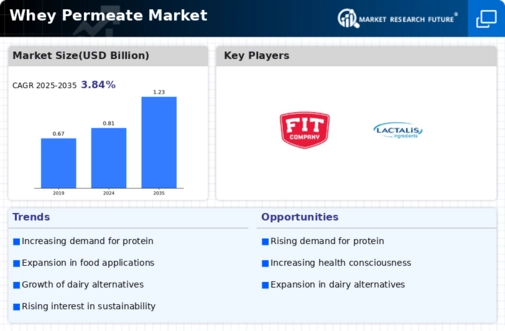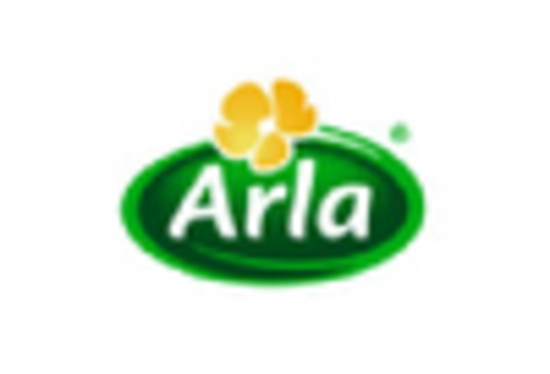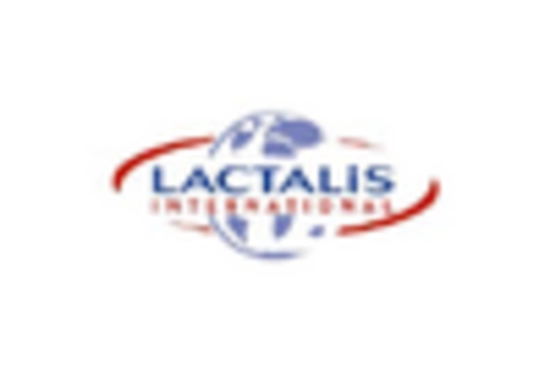Market Share
Introduction: Navigating Competitive Dynamics in the Whey Permeate Market
As the whey permeate market evolves, the competition is increasingly influenced by technological developments, regulatory changes and changes in consumer preferences towards sustainable and health-oriented products. The leading players, mainly food and beverage companies, dietary supplement companies and manufacturers of food and beverage ingredients, compete for leadership through strategic alliances and innovations. Artificial intelligence and automation are enhancing the production efficiency and quality of the ingredients. To meet the consumer demand, food and beverage companies are focusing on clean labeling and sustainable sourcing. IoT-enabled solutions are also enabling the real-time monitoring and supply chain optimization, which is further enhancing the differentiation among market players. The growth opportunities are mainly in North America and Europe, where the health-conscious consumers are driving the demand for whey permeate as a dietary supplement. In 2024–2025, the strategic trends towards product traceability and sustainability are likely to gain momentum, as companies seek to capitalize on the emerging market opportunities.
Competitive Positioning
Full-Suite Integrators
These vendors offer comprehensive solutions across the whey permeate value chain, from sourcing to processing.
| Vendor | Competitive Edge | Solution Focus | Regional Focus |
|---|---|---|---|
| Havero Hoogwegt B.V. | Strong global supply chain network | Whey permeate sourcing and distribution | Europe, Asia |
| Agropur Ingredients | Diverse product portfolio | Dairy ingredient solutions | North America |
| LACTALIS Ingredients | Extensive dairy expertise | Whey and dairy ingredients | Global |
Specialized Technology Vendors
These players focus on innovative technologies and processes for whey permeate production and processing.
| Vendor | Competitive Edge | Solution Focus | Regional Focus |
|---|---|---|---|
| FIT Company | Advanced processing technologies | Whey permeate processing solutions | Europe |
Infrastructure & Equipment Providers
Vendors in this category supply the necessary equipment and infrastructure for whey permeate production.
| Vendor | Competitive Edge | Solution Focus | Regional Focus |
|---|---|---|---|
| Sloan Valley Dairies Lid | Customizable equipment solutions | Dairy processing equipment | North America |
| Melkweg Holland BV. | Specialized dairy processing systems | Dairy infrastructure solutions | Europe |
| Arion Dairy Products B.V. | Focus on sustainable practices | Dairy production equipment | Europe |
Industry Associations
These organizations support the whey permeate market through advocacy, research, and industry standards.
| Vendor | Competitive Edge | Solution Focus | Regional Focus |
|---|---|---|---|
| American Dairy Products Institute | Strong industry advocacy | Dairy industry standards and research | North America |
Major Dairy Producers
Leading dairy companies that produce whey permeate as part of their broader product offerings.
| Vendor | Competitive Edge | Solution Focus | Regional Focus |
|---|---|---|---|
| Arla Foods amba | Global dairy cooperative strength | Dairy products including whey permeate | Global |
| Agri-Dairy Products, Inc | Focus on quality and sustainability | Dairy ingredients and products | North America |
Emerging Players & Regional Champions
- Wheyco (USA): Specializes in high-quality whey permeate for nutritional supplements, recently secured a contract with a major sports nutrition brand, challenging established vendors by offering competitive pricing and superior quality.
- DairyTech Innovations (Europe): Focuses on sustainable whey permeate processing technologies, recently implemented a new eco-friendly production line, complementing established vendors by enhancing sustainability practices in the industry.
- NutraWhey Solutions (Australia): Offers whey permeate solutions to the food and beverage industry. Recently teamed up with a major dairy manufacturer to develop new product lines, it is challenging the traditional suppliers.
Regional Trends: By 2024, Asia-Pacific has a notable increase in whey permeate, driven by the increasing awareness of health and the demand for high-quality protein products. Also, new production technology has lowered the cost of permeate production, resulting in a sharp increase in the number of local whey permeate manufacturers. As the awareness of consumers increases, companies are also investing in green production.
Collaborations & M&A Movements
- Dairy Farmers of America (DFA) and Glanbia Nutritionals entered into a partnership to enhance the production of whey permeate, aiming to increase their market share in the protein ingredients sector amidst rising demand for dairy-based products.
- Arla Foods acquired a minority stake in a start-up focused on innovative whey permeate applications, strategically positioning itself to leverage new technologies and expand its product offerings in the health and wellness market.
- The two companies announced a collaboration on sustainable whey permeate solutions, responding to the growing demand for eco-friendly products and strengthening their position on the international market.
Competitive Summary Table
| Capability | Leading Players | Remarks |
|---|---|---|
| Product Quality | Dairy Farmers of America, Arla Foods | Dairy Farmers of America ensures that the whey permeate it sells is of the highest quality by the application of the strictest quality control measures, thus ensuring the consistency of the product. Arla Foods is able to enhance the nutritional value and purity of its whey permeate through the use of its patented filtration process. |
| Sustainability | Fonterra, Glanbia Nutritionals | Fonterra has a strong commitment to sustainable sourcing and waste reduction. Glanbia Nutritionals has focused on reducing its carbon footprint while maintaining product quality. |
| Innovation in Product Development | Lactalis Ingredients, Agropur | Lactalis is renowned for the original way it uses whey permeate in a wide range of foods, improving both flavour and texture. Agropur has developed unique formulations to meet specific dietary requirements such as lactose-free products, thereby demonstrating its suppleness in product development. |
| Market Reach | Saputo, Kerry Group | Saputo has a robust distribution network that allows for extensive market reach across North America and beyond. Kerry Group utilizes strategic partnerships to penetrate emerging markets, ensuring their whey permeate products are accessible globally. |
| Customer Support and Service | Hilmar Cheese Company, Schreiber Foods | In this way the client is provided with a full range of support services, including technical support for product application, which increases customer satisfaction. Moreover, the company’s prompt and tailored service has established close customer relationships. |
Conclusion: Navigating the Whey Permeate Landscape
Whey permeate market in 2024 is characterized by a high degree of competition and significant fragmentation, with both established and new players fighting for a larger share of the market. The North American and European markets are characterized by a high growth in demand, which is mainly driven by rising health consciousness and the growing popularity of plant-based diets. Strategically, suppliers are able to take advantage of this trend by introducing advanced capabilities, such as artificial intelligence for predicting customer needs, automation for efficient production and sustainable initiatives to meet customer expectations. In addition, the ability to offer a flexible product portfolio will be important to meet the market's changing preferences. As a result, these capabilities will be the key to establishing leadership and gaining a competitive advantage.

















Leave a Comment